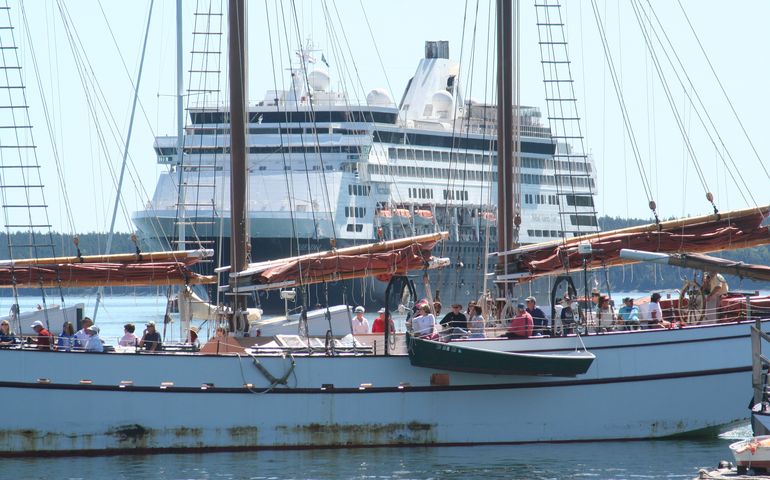
Bar Harbor grapples with vehicle congestion on cruise ship days
 Photo / Laurie Schreiber
Cruise ship and tour boat passengers converge in downtown Bar Harbor, along with shoreside tours, shuttle buses, regular vehicular traffic and pedestrians.
Photo / Laurie Schreiber
Cruise ship and tour boat passengers converge in downtown Bar Harbor, along with shoreside tours, shuttle buses, regular vehicular traffic and pedestrians.
Bar Harbor is seeing its highest number of cruise ships ever this year. On the schedule for the season are 176 ships carrying 254,546 passengers.
Twenty years ago, in 1999, those numbers were 39 ships and 25,485 passengers.
As a result, the town wharf, where most passengers arrive on shore, is often a congested jumble of vehicles and people. Designed and historically used as a working pier for fishermen and other maritime activities, it’s now mostly a waterfront lot packed with vehicles coming, going and parking. They include day-trippers' cars, large motor coaches, minibuses and vans that provide shoreside tours for cruise ship passengers, other tour vehicles and the Island Explorer shuttle bus.
In July, the Bar Harbor Town Council received a report, commissioned by the Cruise Line Industry Association at the council’s request, on the traffic congestion and recommendations to alleviate it.
“One takeaway from the consultant’s report is that Bar Harbor doesn’t have a lot of space,” said Councilor Stephen Coston. “We’re a small town to accommodate a lot of people.”
In recent weeks, the Bar Harbor Police Department has begun implementing some of the recommendations on a trial basis.
Reporting to the council at its Oct. 1 meeting, Police Chief Jim Willis said an initial goal is to better separate pedestrians and vehicle traffic.
“It’s such a small area that when you change one little thing it changes everything,” Willis said.

The report’s recommendations include measures like controlled vehicle entry to the wharf area and reconfigured traffic flow along the narrow streets that lead to the area.
Willis said a first step — barrier tape to channel people waiting for tour buses onto the sidewalks and out of the street — has worked well.
“We’ve changed traffic flow,” he said. “I think that’s caused locals some confusion and frustration. But we’re trying to accommodate them. If a fisherman needs to pass through the barrier area, we lift up the tape. It’s controlled access rather than wide open like it used to be.”
The department is also experimenting with reconfigured transit and parking patterns for cruise-ship tour buses and other types of tour vehicles, he said.
“They can get jammed up because that’s where they park,” he said. “So our approach is to try a few ideas and, if they’re working well, make them better with capital improvements like hardscaping.”
Next steps, like hardscaping, will require additional professional consultation and investment, he added.
“We’ll continue to tweak things next year,” he said. “We’re still working on traffic configurations.”
Willis said the situation also affects his department’s staffing. Some officers work overtime, on days off or on double shifts.
“With the changes we’re making, it will take even more staff,” Willis said.
In a Sept. 13 memo to the cruise ship committee, Willis explained the department is working on a plan to combine its parking enforcement staff with its cruise ship staff into a new “special services” division. The vision is to have a full-time, year-round police supervisor, as a new position to manage parking enforcement and cruise ship activities with support from officers, and seasonal civilian personnel who would do parking enforcement and the crossing guard work.
“The challenge is always finding the help to do that,” he told the council. “But it’s time to stop relying on overtime.”
Eben Salvatore, a member of the town’s Cruise Ship Committee and director of local operations for Ocean Properties, which owns the large West Street Hotel near the town wharf, said that also needed at the wharf are better wayfinding signs.
“Every single person climbs the ramp [from the cruise ship tender to shore] with questions,” he said. “We have multiple opportunities to intercept that ahead of time. The private side has ideas how to help.”
Salvatore noted that initial changes at the wharf are just one part of the overall challenge of people and vehicle movement through town.
“This is the start of a bigger process,” he said.










0 Comments